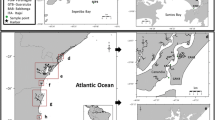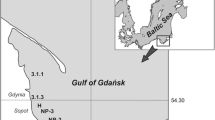Abstract
The distribution and accumulation of butyltins in various tissues of 13 benthic and pelagic species living in the sub-Arctic Saguenay Fjord (Canada) were investigated. Butyltin contamination was ubiquitous in this ecosystem with tributyltin (TBT) biota to sediment accumulation factors (BSAF) ranging between 0.22 and 11, but without any important biomagnification between trophic levels. The large range of butyltin compounds accumulating within different tissues of the species collected from all trophic levels was from 7 to 1238 ng Sn g−1 d.w. and indicates an exceptional contamination level only found in northern coastal areas exposed to an intensive traffic of commercial ships. Results show that bioaccumulation in organisms depends on three main factors: (1) the actual contamination level in their habitat, (2) their assimilation pathway by water, sediment or diet, and (3) their ability to metabolize TBT and excrete metabolites. By their lack of an efficient TBT degradation system, bivalves are subject to accumulate more butyltins (from 890 to 993 ng Sn g−1 d.w. for TBT and from n.d to 138 ng Sn g−1 d.w. for metabolites) whereas most burrow-dwelling organisms are able to degrade TBT and their butyltin levels ranged from 86 to 239 ng Sn g−1 d.w. for TBT and from 7 to 106 ng Sn g−1 d.w. for metabolites. Acadian redfish (Sebastes fasciatus) feeding preferentially on shrimps and small crustaceans rich in TBT showed a contamination level about three times higher than eelpout (Licodes vahlii). The latter species living in contact with the sediment and feeding on worms and other burrowing species had a lower proportion of TBT in their tissues. Finally, deleterious effects of butyltins in the Saguenay Fjord were assessed by the significant occurrence of Imposex in common whelk (Bucinum undatum) in two sites from Baie des Ha! Ha!. Results revealed that the effects of Imposex were accentuated close to the source of contamination, at Port-Alfred harbour, since the total of imposexed whelks collected at site A (the mouth of Baie des Ha! Ha!) was 12.5% and reached 52.6% at site B (Port Alfred). Although the incidence or frequency of imposex was low in site A compared to site B, the relative penile length index (RPL) values, a measure of the degree or severity of imposex, was similar at both sites indicating the presence of TBT with higher concentrations in site B.







Similar content being viewed by others
References
Albalat A, Potrykus J, Pempkowiak J, Porte C (2002) Assessment of organotin pollution along the Polish coast (Baltic Sea) by using mussels and fish as sentinel organisms. Chemosphere 47:165–171
Alzieu C (2000) Impact of tributyltin on marine invertebrates. Ecotoxicology 9:71–76
Andersson T, Förlin L (1992) Regulation of the cytochrome P450 enzyme system in fish. Aquat Toxicol 24:1–20
Barron MG (1990) Bioconcentration. Will water-borne organic chemicals accumulate in aquatic animals? Env Sci Technol 24:1612–1618
Békri K, Pelletier É (2004) Trophic transfer and vivo immunotoxicological effects of tributyltin (TBT) in polar seastar Leptasterias polaris. Aquat Toxicol 66:39–53
Brêthes JC, Parent B, Pellerin J (1994) Enzymatic activity as an index of trophic resource utilization by the snow crab chionoecetes opilio (O. fabricius). J Crust Biol 14:220
Bryan GW, Gibbs PE, Hummerstone LG, Burt GR (1989) Uptake and transformation of super (14)C-labelled tributyltin chloride by the dog-whelk, N. lapillus, importance of absorption from the diet. Mar Environ Res 28:241–245
Bryan GW, Bright DA, Hummerstone LG, Burt GR (1993) Uptake, tissue distribution and metabolism of super (14)C-labelled tributyltin (TBT) in the dog-whelk, Nucella lapillus. J Mar Biol Assoc UK 73:889–912
Chau YK, Yang F, Brown M (1997) Evaluation of derivatization techniques for the analysis of organotin compounds in biological tissue. Anal Chim Acta 338:51–55
Evans SM ,Nicholson GJ (2000) The use of imposex to assess tributyltin contamination in coastal waters and open seas. Sci Total Environ 258:73–80
Gagné F, Blaise C, Pellerin J, Pelletier É, Douville M, Gauthier-Clerc S, Viglino L (2003) Sex alteration in soft-shell clams (Mya arenaria) in an intertidal zone of the Saint Lawrence River (Quebec, Canada). Comp Biochem Physiol Part C 134:189–198
Gascon D (2003) Redfish multidisciplinary research zonal program (1995–1998): final report. Canadian Technical Report of Fisheries and Aquatic Sciences 2462:152
Gibbs PE, Pascoe PL, Burt GR (1988) Sex change in the female dog-whelk, Nucella lapillus, induced by tributyltin from antifouling paints. J Mar Biol Assoc UK 68:715–731
Gobeil C, Clermont Y, Paquette G (1997) Concentrations en mercure, plomb et cadnium chez divers espèces de poissons de fond, poissons pélagiques et de crustacés de l’estuaire et du golfe du St Laurent et du fjord du Saguenay. Rapport statistique canadien des sciences halieutiques et aquatiques [Mercury, lead, and cadmium concentrations in crustacea and several fish species from the Estuary and Gulf of St-Lawrence and from the Saguenay Fjord. Canadian Statistical Report of Fisheries and Aquatic Sciences], Institut Maurice-Lamontagne Mont-joli (QC) 1011:83
Jobling S, Casey D, Rodgers-Gray T, Oehlmann J, Schulte-Oehlmann U, Pawlowski S, Baunbeck T, Turner AP, Tyler CR (2003) Comparative responses of molluscs and fish to environmental estrogens and an estrogenic effluent. Aquat Toxicol 65:205–220
Kannan K, Falandysz J (1997) Butyltin residues in sediment, fish, fish-eating birds, harbour porpoise and human tissues from the Polish coast of the Baltic Sea. Mar Pollut Bull 34:203–207
Kannan K, Senthilkumar K, Elliott JE, Feyk LA, Giesy JP (1998) Occurrence of butyltin compounds in tissues of water birds and seaducks from the United States and Canada. Arch Environ Contam Toxicol 35:64–69
Kannan KS, Tanabe S, Tatsukawa R (1995) Phenyltin residues in horseshoes crabs, Tachypleus tridentatus from Japanese coastal waters. Chemosphere 30:925–932
Langston WJ (1996) Recent developments in TBT ecotoxicology. Toxicol Environ News 3:179–187
Langston WJ, Burt GR (1991) Bioavailability and effects of sediment-bound TBT in deposit feeding clams, Scrobicularia plana. Mar Environ Res 32:61–77
Langston WJ, Bryan GW, Burt GR, Pope ND (1994) Effects of sediment metals on estuarine benthic organisms. R&D Note 203, National Rivers Authority, Plymouth (UK), 141
Lee RF (1986) Metabolism of bis(tributyltin) oxide by estuarine animals. In Proceedings of the Organotin Symposium, Oceans’86 Conference, Marine Technology Society, Washington, DC, USA, pp 1182
Lee RF (1991) Metabolism of tributyltin by marine animals and possible linkages to effects. Mar Environ Res 32:29–35
Lee RF, Valkirs AO, Seligman PF (1989) Importance of microalguae in the biodegradation of tributyltin in estuarie waters. Env Sci Technol 23:1515–1518
Maguire RJ (2000) Occurrence and seasonal variation of tributyltin in marinas on Lake Ontario, Canada. Wat Qual Res J Can 4:681–691
Mamelona J, Pelletier É (2003) Butyltins biomagnification from macroalgae to green sea urchin: a field assessment. Appl Organomet Chem 17:759–766
Martell A, Larrivee DH, Himmelman JH (1986) Behaviour and timing of copulation and egg-laying in the neogastropod Buccinum undatum. J Exp Mar Biol Ecol 1:27–42
Meador JP, Rice CA (2001) Impaired growth in the polychaete Armandia brevis exposed to tributyltin in sediment. Mar Environ Res 51:113–129
Mensik BP, ten Hallers-Tjabes CC, Kralt J, Freriks IL, Boon JP (1996) Assessment of Imposex in the common whelk, Buccinum undatum from the Eastern Scheldt, the Netherlands. Mar Environ Res 4:315–325
Michaud M-H (2004) Dynamic of butyltins in the ecosystem of St. Lawrence Estuary. Master, Thesis, University of Quebec, Rimouski, Canada, p 85
Minchin D, Bauer B, Oehlmann J, Schulte-Oehlmann U, Duggan CB (1997) Biological indicators used to map organotin contamination from a fishing port, Killybegs, Ireland. Mar Pollut Bull 34:235–243
Mousseau P, Armellin A (1995) Synthèse des connaissances sur les communautés biologiques du Saguenay. Rapport technique. Zones d’intervention prioritaire 22 et 23. Environnement Canada, Région du Québec, Conservation de l’environnement, Centre Saint-Laurent, pp 246
Nicholson GJ, Evans SM (1997) Anthropogenic impacts on the stocks of the common whelk Buccinum undatum (L). Mar Environ Res 44:305–314
Pechenick, Jan. A (2000) Biology of the invertebrates, 4th ed, Boston, Toronto: McGraw-Hill, 1985, pp 578
Regoli L, Chan HM, de Lafontaine Y, Mikaelian I (2001) Organotins in zebra mussels (Dreissena polymorpha) and sediments of the Quebec City harbour area of the St. Lawrence River. Aquat Toxicol 53:115–126
Rouleau C, Gobeil C, Tjălve H (1999) Pharmacokinetics and distribution of dietary tributyltin and methylmercury in the snow crab (Chionoecetes opilio). Environ Sci Technol 33:3451–3457
Sarradin PM, Lapaquellerie Y, Astruc A, Latouche C, Astruc M (1995) Long term behaviour and degradation kinetics of tributyltin in a marina sediment. Sci Total Environ 170:59–70
Schafer CT, Smith JN, Côté R (1990) The Saguenay Fjord: A major tributary to the St. Lawrence Estuary. In: El-Sabh MI, Silverberg N (eds) Oceanography of a large-Scale Estuarine System. Coastal and estuarine Studies, Vol. 39. Springer-Verlag, New-York, p 378–420
Senthilkumar K, Duda CA, Villeneuve DL, Kannan K, Falandysz J, Giesy JP (1999) Butyltin compounds in sediment and fish from the Polish coast of Baltic sea. Environ Sci Pollut 6:200–206
Shawky S, Emons H (1998) Distribution pattern of organotin compounds at different trophic levels of aquatic ecosystems. Chemosphere 3:523–535
St-Jean SD, Courtenay SC, Pelletier É, St-Louis R (1999) Tributyltin concentrations in sediments and blue mussels (Mytilus edulis) of the southern Gulf of St. Lawrence, Canada. Environ Technol 20:181–189
St-Louis R, Pelletier É, Marsot P (1997) A mechanistic approach to tributyltin (TBT) sorption by marine microflagellated alga Pavlova lutheri. Appl Organ Chem 11:543–550
St-Louis R, de Mora S, Pelletier É, Doidge B, Leclair D, Mikaelian I, Martineau D (2000) Hepatic butyltin concentrations in Beluga Whales (Delphinapterus leucas) from the St. Lawrence Estusary and Northern Quebec, Canada. Appl Organo Chem 14:218–226
Strand J, Jacobsen JA, Pedersen B, Granmo A (2003) Butyltin compounds in sediment and molluscs from the shipping strait between Denmark and Sweden. Environ Pollut 124:7–15
Sudaryanto A, Takahashi S, Monirith I, Ismail A, Muchtar M, Zheng J, Richardson BJ, Subramanian A, Prudente M, Duc Hue N, Tanabe S (2002) Asia-Pacific mussel watch:monitoring of butyltin contamination in coastal waters of Asian developing countries. Env Toxicol Chem 10:2119–2130
Takahashi S, Tanabe S, Tsunemi K (1997) Deep sea organisms collected from Suruga Bay, Japan. Environ Sci Technol 31:3103–3109
Takahashi S, Tanabe S, Takeushi I, Miyazaki N (1999) Distribution and specific bioaccumualtion of butyltin compounds in a marine ecosystem. Arch Environ Contam Toxicol 37:50–61
Takeuchi I, Takahashi S, Tanabe S, Miyazaki N (2001) Caprella watch: a new approach for monitoring butyltin residues in the ocean. Mar Environ Res 52:97113
Ten Hallers-Tjabbes CC, Wegener JW, Van Hattum B, AGM, Kemp JF, Ten Hallers E, Reitsema TJ, Boon JP (2003) Imposex and organotin concentrations in Buccinum undatum and Neptunea antiqua from the North Sea: relationship to shipping density and hydrographical conditions. Mar Environ Res 55: 203–233
Tetreault F, Himmelman JH, Measures L (2000) Impact of a castrating trematode, Neophasis sp., on the common whelk, Buccinum undatum, in the northern Gulf of St. Lawrence. Biol Bull 198:261–271
Tselentis BS, Tzannatos ES (2000) Butyltin compounds in coastal sediments of areas associated with maritime facilities in Greece. Fresenius Environ Bull 9:499–507
Vladykov VD (1946) Nourriture du marsouin blanc ou beluga (Delphinapterus lucas) du fleuve Saint Laurent. Contribution du département des pêcheries, Québec, no. 17, pp 132
Viglino L, Pelletier É, St Louis R (2004) Highly persistent butyltins in Northern marine sediments: a long term threat for the Saguenay Fjord (Canada). Environ Toxicol Chem 23:2673–2681
Viglino L, Pelletier É (2005) Butyltins in waters of Saguenay Fjord (Canada): a threat for a semi-enclosed aquatic ecosystem? Rev Sci Eau (in press)
Acknowledgments
The authors wish to thank G. Canuel and K. Belzile for their excellent technical assistance and suggestions. This research was supported by the Canadian Research Chair in molecular ecotoxicology and NSERC-Discovery grant (E.P.).
Author information
Authors and Affiliations
Corresponding author
Rights and permissions
About this article
Cite this article
Viglino, L., Pelletier, É. & Lee, L.E.J. Butyltin Species in Benthic and Pelagic Organisms of the Saguenay Fjord (Canada) and Imposex Occurrence in Common Whelk (Buccinum undatum). Arch Environ Contam Toxicol 50, 45–59 (2006). https://doi.org/10.1007/s00244-004-0198-6
Received:
Accepted:
Published:
Issue Date:
DOI: https://doi.org/10.1007/s00244-004-0198-6




